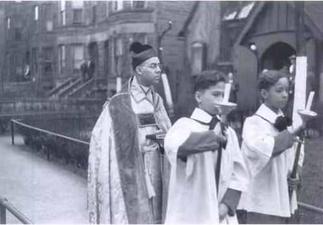Our History
 Fr. Martin
Fr. Martin
St. Edmund’s Episcopal Church is one of the oldest and most renowned and active predominantly black Episcopalian congregations in Chicago. Throughout most of its history the church is officially called the “Church of St. Edmund, King and Martyr,” but it is commonly known as “St. Edmund’s Episcopal Church.” First known as the Washington Park Mission, St. Edmund, King and Martyr dates to 1905, when its first congregants celebrated mass in a basement at 55th Street and Wabash Avenue in Chicago. The nascent church changed its name to St. Edmund’s Mission in 1906 and later moved to the second floor of the Citizen’s Trust and Savings Bank at 55th and State streets. The small congregation moved again on Easter 1908 to 5831 S. Indiana Avenue. In September 1940, the mission made a formal application to the Episcopal Diocese of Chicago for admission as a parish. The application was approved by the Diocesan Convention; the St. Edmund’s Church charter was filed October 12, 1940. After raising the capital funds and securing a grant from the Diocese of Chicago, the parish moved to its present location, acquiring the former Greek Orthodox Church of St. Constantine at 6105 S. Michigan Avenue.
St. Edmund’s Episcopal Church is one of the oldest and most renowned and active predominantly black Episcopalian congregations in Chicago. Throughout most of its history the church is officially called the “Church of St. Edmund, King and Martyr,” but it is commonly known as “St. Edmund’s Episcopal Church.” First known as the Washington Park Mission, St. Edmund, King and Martyr dates to 1905, when its first congregants celebrated mass in a basement at 55th Street and Wabash Avenue in Chicago. The nascent church changed its name to St. Edmund’s Mission in 1906 and later moved to the second floor of the Citizen’s Trust and Savings Bank at 55th and State streets. The small congregation moved again on Easter 1908 to 5831 S. Indiana Avenue. In September 1940, the mission made a formal application to the Episcopal Diocese of Chicago for admission as a parish. The application was approved by the Diocesan Convention; the St. Edmund’s Church charter was filed October 12, 1940. After raising the capital funds and securing a grant from the Diocese of Chicago, the parish moved to its present location, acquiring the former Greek Orthodox Church of St. Constantine at 6105 S. Michigan Avenue.
 Fr. Mitchell
Fr. Mitchell
The church has been a pillar of the Washington Park community since its earliest days. This congregation was the church of choice for many of black Chicago’s cultural, civic and professional elites, with members including noted journalist Vernon Jarrett, prominent lawyer and civil rights activist Earl B. Dickerson, who was known as the “dean of black Chicago lawyers,” and physician and socialite Bernyce DeFreitas. During the church’s illustrious mid-century period, celebrated soprano Leontyne Price performed at a series of concert fundraisers, and members were frequently featured in the society pages of the Chicago Defender and other black publications around the country. Photographs of St. Edmund’s Church were included in Richard Wright’s celebrated 1941 book, 12 Million Black Voices, a work that sought to illustrate the broad and varied nature of the African American experience in a large Northern city. The church and its members were depicted as representative of upper-middle- and upper-class black society during the height of the Great Migration.
However, as the community fell victim to blight and urban renewal in the 1960s, many of its congregants moved farther away from the neighborhood and decamped to the city’s North Side and surrounding suburbs, creating a largely commuter congregation. Yet, given the church’s strong commitment to social issues and civil rights, parishioners and parish priests have worked to improve the economic condition of the Washington Park neighborhood, and have promoted the arts and education within Chicago’s black communities.
The first leader of St. Edmund’s Church helped to foster this impetus toward social outreach. Father Samuel Joseph Martin was born June 5, 1905 in Huntsville, Ala., the son of Baptist minister John Thomas Martin and his wife, Dorrence. After receiving his education at the Episcopal Seminary in Virginia, Martin was tapped by church leadership in 1928 to develop a black parish from the embers of a dying white Chicago congregation. Twenty years later the church’s membership rolls had grown to more than a thousand, and St. Edmund’s had gained a reputation as one of the leading parishes of black Chicago. Although the neighborhood’s fortunes declined by the 1960s, the church’s members remained committed to the struggle for civil rights, donating time, money and resources to the cause.
The second leader of St. Edmund's, Rev. Raymond S. Mitchell, was a native of Pennsylvania and received his B.S. in education from Cheyney University and later received a Masters of Theology from the Philadelphia Divinity School, an Episcopal seminary. After ordination he became priest at St. Cyprian’s, Philadelphia, and later at St. Phillips in Syracuse, NY. St. Phillips became one of the leading churches in the city, largely due to his hard work and community affiliations. In 1961, following his tenure in Syracuse, Rev. Mitchell served as priest of St. Phillip’s Church in Richmond, VA. where he also served on many committees and was the first Black president of the Richmond Clericus.
- For a look at the written history of St. Edmund's Church, from 1905-2005, click here
- For a brief video overview of the history of Washington Park, click here
====================================================================================================================================
6105 S. Michigan Avenue | Chicago, IL 60637-2192 | Office (773) 288-0038 | Fax (773) 288-0459 | Directions | Email
6105 S. Michigan Avenue | Chicago, IL 60637-2192 | Office (773) 288-0038 | Fax (773) 288-0459 | Directions | Email


